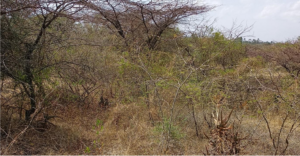Introducing CROSSROADS: Using native plants to restore biodegraded soils in Ethiopia
The first in-person meeting of the CROSSROADS project was held between 10 and 14th March, 2025 in Hawassa, Ethiopia. CROSSROADS is one of the new projects awarded last year under the GCBC’s Second Research Grant Competition (RGC2).
Researchers from lead partner, the University of Aberdeen (Scotland), and the International Water Management Institute (Addis Ababa, Ethiopia), travelled to Hawassa to meet partners from the Central Ethiopian Agricultural Research Institute and Hawassa University.
A healthy soil is the basis for improved rural livelihoods and resilience to climate change. Using side-lined plant species to improve soils could increase their value and so encourage their spread. CROSSROADS aims to catalogue and rate side-lined species with potential to restore agriculturally degraded soils. This will use a combination of systematic review of the existing scientific literature, community engagement to draw together traditional knowledge, new field and lab measurements, and modelling.
A major component of the project is the development of new tools to communicate findings, dissemination of tools and facilitation of use of top-rated species.
Fighting soil erosion with innovation
A visit to potential field sites in the area of Lokka Abaya, South of Hawassa, highlighted the limitations on organic inputs available to improve the soil; a high proportion of crop residues are used for livestock feed, fuel or building. Land pressures reduce the amount of space available for wild species to proliferate, resulting in high potential for biodiversity loss. Many of these wild species could be used to improve soils by adding or releasing nutrients, or by stabilising the soil with their roots to reduce erosion.

The CROSSROADS team visited an exclosure area in the kebele (the smallest administrative unit in Ethiopia). Exclosures are formerly degraded areas where livestock and cropping have been excluded to allow time for the fertility of the land to recover. An important idea to emerge from this visit was the potential to encourage the top-rated side-lined species to grow in exclosures, providing a source of seeds for plants, which could then be collected by local entrepreneurs and used for soil improvement.
In research aligned to the GCBC CROSSROADS project, University of Aberdeen and Hawassa University researchers worked together to construct a laboratory rainfall simulator at Hawassa University. This new equipment allows for controlled testing of soil erosion, providing detailed information on soil loss and water flow under rainfall conditions typical of the regions we are exploring. Livestock, especially grazing in communal grazing areas, are responsible for high levels of erosion. We are using the rainfall simulator to evaluate how biodiverse plants and different types of land management can combat soil erosion, arguably the greatest threat to agriculture in sub-Saharan Africa.
A rainfall nozzle and pressure controllers were brought from the UK; these match equipment already in place in the laboratory at the University of Aberdeen. In Ethiopia we scoured markets to buy consumables and worked with local tradespeople to construct a 4 m tower from bamboo with metal erosion troughs to hold soil during testing. Delivering water to the rainfall simulator required a water supply to be diverted to a large holding tank, which is then pumped at controlled pressure to regulate rainfall intensity.
Early results have found improved stabilisation in soils collected near to homesteads (where more biodiverse plants are grown) compared to soils from further away (where fields are planted with monocultures). With this equipment now in place, there are many opportunities to explore the impacts of specific plants or biodiverse mixtures, with the objective of demonstrating how side-lined plant species could help combat erosion by improving soils. By using underutilised plant species, both above and below-ground, biodiversity will be enhanced through increased use of indigenous crops, trees and shrubs to improve fertility and reinforce unstable soils. The extent of this and the consequent impacts on soils, biodiversity, poverty and climate adaptation will be fully quantified and understood through the CROSSROADS project.







